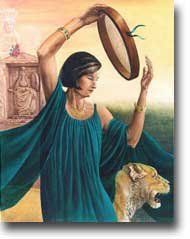|
The English Mothering SundayThe timing Hilaria corresponds with the modern celebration of Mother's Day in England. "Mothering Sunday", also called Mid-Lent Sunday, is observed on the fourth Sunday in Lent. Some say the ceremonies in honor of Cybele were adopted by the early church to venerate the Mother of Christ, Mary. Others believe the Mother Church was substituted for mother goddess and custom began to dictate that a person visit the church of his/her baptism on this day. People attended the mother church of their parish, laden with offerings. In England, in the 1600's, young men and women who were apprentices or servants returned home on Mothering Sunday, celebrated on the 4th Sunday of Lent (the 40 day period leading up to Easter). During this time many of the England's poor worked as servants for the wealthy, and as most jobs were located far from their homes, the servants would live at the houses of their employers. On Mothering Sunday the servants would have the day off and were encouraged to return home and spend the day with their mothers. They would bring to their mothers small gifts like trinkets or a "mothering cake". Sometimes furmety was served - wheat grains boiled in sweet milk, sugared and spiced. In northern England and in Scotland, the preferred refreshments were carlings - pancakes made of steeped pease fried in butter, with pepper and salt. In fact, in some locations this day was called Carling Sunday. Another kind of mothering cake was the simnel cake, a very rich fruit cake. The Lenten fast dictated that the simnel cake had to keep until Easter. It was boiled in water, then baked, and was often finished with an almond icing. Sometimes the crust was of flour and water, colored with saffron. As Christianity spread throughout Europe the celebration changed to honor the "Mother Church" - the spiritual power that gave them life and protected them from harm. Over time the church festival blended with the Mothering Sunday celebration. People began honoring their mothers as well as the church. Mother's
Day Index
Mother's
Day Forum
|
|
||||||||||||
